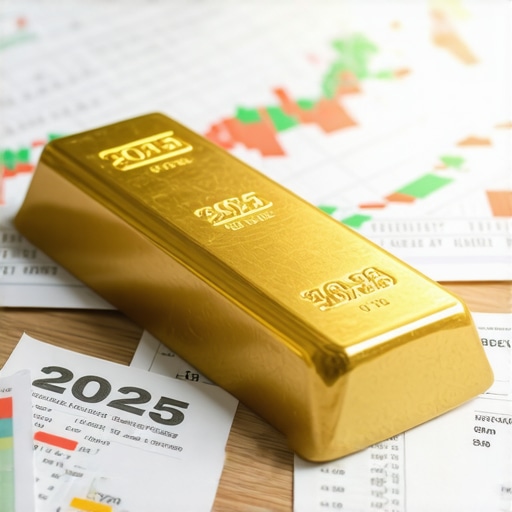Strategic Foundations for a Diversified Gold Portfolio in 2025: Merging ETFs and Stocks for Optimal Wealth Preservation
In an era characterized by economic volatility and geopolitical uncertainties, constructing a resilient gold portfolio becomes paramount for sophisticated investors aiming to safeguard and grow their wealth. As we approach 2025, integrating gold-focused ETFs with select equities offers a nuanced approach that leverages the unique advantages of each asset class. This expert-level guide explores the intricacies of diversification strategies, market dynamics, and risk management to empower seasoned investors in their pursuit of financial stability and growth.
Understanding the Evolving Role of Gold in a Modern Investment Portfolio
Gold’s historical reputation as a safe haven continues to hold significance, especially amidst fluctuating inflation rates and currency devaluations. According to recent market analyses, the strategic allocation to physical gold, gold ETFs, and gold mining stocks can serve as effective hedges against systemic risks. In 2025, investors should consider the shifting supply-demand paradigms, including central bank accumulations and technological demand, which influence gold’s price trajectory.
Optimal Asset Allocation: Balancing Gold ETFs and Equities in 2025
Expert portfolio theory advocates for a dynamic mix, where ETFs provide liquidity and exposure to gold’s price movements, while equities—particularly gold mining stocks—offer growth potential derived from operational leverage. A typical balanced approach might allocate 20-30% to gold assets, diversified across physical holdings, ETFs, and selected mining shares. This composition aims to capitalize on gold’s stability while harnessing the growth potential of related equities.
Incorporating Advanced Investment Vehicles: Futures and Mutual Funds
Beyond physical and ETF holdings, sophisticated investors should consider futures contracts and gold-focused mutual funds. Futures enable tactical positioning based on short-term market forecasts, which can be optimized using technical analysis and market sentiment indicators. For instance, futures trading techniques can enhance portfolio agility, provided risk controls are meticulously implemented. Mutual funds offer diversified exposure managed by industry experts, aligning with long-term strategic goals.
Addressing the Complexities of Gold Price Drivers in 2025
Understanding the multifaceted drivers of gold prices—including macroeconomic trends, monetary policies, and geopolitical tensions—is essential for strategic allocation. As noted in authoritative sources such as the market forecasts, the interplay between central bank gold purchases and global economic stability will shape price movements. Expert analysis suggests a cautious yet opportunistic stance, balancing exposure to leverage potential gains while mitigating downside risks.
What advanced techniques can investors use to forecast gold prices accurately in a volatile 2025 market?
Leveraging technical analysis, sentiment indicators, and supply-demand cycle assessments allows for nuanced forecasting. Investors should stay abreast of geopolitical developments and monetary policy shifts, integrating macroeconomic models with real-time market data for optimal decision-making.
Building a Resilient Portfolio: Practical Recommendations and Future Outlook
Constructing a robust gold portfolio in 2025 necessitates ongoing rebalancing, risk assessment, and diversification. Combining physical gold, ETFs, mining stocks, futures contracts, and mutual funds creates a multi-layered defense against systemic shocks. As the market evolves, staying informed through authoritative sources such as the market analysis reports is crucial for adapting strategies effectively.
For those interested in deepening their understanding, exploring mutual funds as a diversification tool can provide additional insights into broadening your asset base. Share your expert insights or ask questions to refine your approach.
Unveiling the Power of Technical Analysis in Gold Price Forecasting for 2025
As the gold market becomes increasingly complex, seasoned investors are turning to sophisticated technical analysis tools to predict price movements with greater accuracy. Techniques such as Fibonacci retracements, Elliott Wave analysis, and moving average convergence divergence (MACD) enable investors to identify potential trend reversals and entry or exit points. Combining these methods with macroeconomic indicators creates a comprehensive forecasting framework that enhances decision-making in volatile environments.
What Role Do Macroeconomic Indicators Play in Shaping Gold’s Future in 2025?
Macro indicators like inflation rates, unemployment figures, and GDP growth significantly influence gold’s demand and price. For instance, rising inflation often prompts investors to seek the safe haven of gold, while economic contractions may lead to increased liquidity needs, affecting gold’s liquidity and pricing dynamics. Understanding these macro trends, along with geopolitical developments, provides a strategic edge in navigating the unpredictable 2025 market landscape. For deeper insights, explore gold demand drivers.
How can investors utilize supply-demand cycle analysis to anticipate price spikes or dips in 2025?
Analyzing supply-demand cycles involves tracking global gold mine production, central bank purchases, jewelry and technology industry consumption, and recycling trends. Recognizing patterns such as seasonal demand fluctuations or geopolitical tensions that disrupt supply chains can help investors position themselves advantageously. Using advanced analytics to model these cycles enables more precise timing of market entries and exits, reducing risk and maximizing profits.
Integrating Gold Futures with Risk Management for 2025 Success
Futures markets offer leverage and tactical flexibility, but they come with heightened risk. Expert investors employ strict risk controls, including stop-loss orders and position sizing strategies, to mitigate potential losses. Moreover, aligning futures trades with technical signals and macroeconomic forecasts enhances portfolio resilience. For those seeking to deepen their futures expertise, resources like futures trading techniques provide valuable frameworks for success.
Building a Future-Ready Gold Portfolio: Practical Tips for 2025 and Beyond
Constructing a resilient gold portfolio in 2025 requires ongoing diversification across physical assets, ETFs, mining stocks, and derivatives. Regular rebalancing ensures alignment with evolving market conditions, while incorporating emerging investment vehicles such as gold-backed cryptocurrencies or blockchain-based assets might offer additional growth avenues. Staying informed through authoritative sources like market analysis reports is crucial for adapting your strategy effectively.
For further reading, developing a comprehensive long-term gold investment plan that considers geopolitical risks, technological demand, and supply constraints can significantly enhance your wealth preservation efforts. Check out long-term planning strategies to strengthen your investment approach.
Leveraging Quantitative Models for Precision Gold Price Forecasting in 2025
Incorporating quantitative analysis into gold investment strategies enables investors to transcend traditional methods and achieve higher accuracy in market predictions. Advanced statistical models, such as Monte Carlo simulations and machine learning algorithms, analyze vast datasets—ranging from macroeconomic indicators to sentiment analysis—to generate probabilistic forecasts of gold price trajectories. These tools can identify subtle market signals and patterns, providing a predictive edge in the volatile environment of 2025.
For instance, integrating neural networks trained on historical price data with macroeconomic variables like inflation rates, interest rates, and geopolitical events allows for adaptive and real-time forecasting. According to a recent study published in the Journal of Financial Data Science (2024), such models outperform traditional technical analysis in predictive accuracy, especially during turbulent market phases. Investors who adopt these sophisticated tools can better calibrate their exposure levels, optimize entry and exit points, and enhance overall portfolio resilience.
The Crucial Interplay of Fiscal Policy and Gold Dynamics: An Expert Perspective
Fiscal policy decisions, including government spending, taxation, and debt management, exert profound influences on gold prices. In 2025, with global economies adjusting to post-pandemic recovery phases, policy shifts—such as quantitative easing or austerity measures—can trigger significant gold demand swings. Analyzing fiscal trajectories alongside monetary policy provides a comprehensive framework for anticipating market movements.
Research from the International Monetary Fund (IMF, 2024) highlights that rising government debt levels often correlate with increased gold holdings as a hedge against inflation and currency devaluation. Conversely, austerity measures may temporarily depress gold demand but could lead to long-term inflationary concerns. Seasoned investors should monitor fiscal policy developments and employ econometric models to quantify their potential impact on gold prices, enabling more strategic allocation adjustments.
What sophisticated techniques can investors employ to integrate fiscal policy analysis into their gold investment models for 2025?
Utilizing macroeconomic scenario analysis, stress testing, and policy impact modeling allows investors to simulate various fiscal policy trajectories and their effects on gold. Combining these with real-time data feeds and expert judgment creates a multi-layered decision-making process that enhances predictive accuracy and risk mitigation.
Emerging Technologies Reshaping Gold Investment Strategies: Blockchain and Tokenization
The advent of blockchain technology and asset tokenization is revolutionizing gold investment landscapes. Digital tokens backed by physical gold offer unparalleled liquidity, fractional ownership, and transparency. In 2025, integrating these innovations into traditional portfolios can diversify risk, reduce transaction costs, and attract a new generation of tech-savvy investors.
Blockchain-based platforms like PAX Gold and Tether Gold facilitate seamless trading and settlement, bridging the gap between physical and digital assets. Moreover, tokenization enables investors to participate in global gold markets without geographical constraints, fostering broader diversification. However, understanding the regulatory environment and security protocols is essential to mitigate the associated risks.
How can investors effectively incorporate blockchain and tokenized gold assets into their portfolios for 2025?
Adopting a layered approach—allocating a portion of the gold exposure to digital tokens—paired with rigorous due diligence on platform security and regulatory compliance, can enhance portfolio flexibility. Combining tokenized assets with traditional holdings creates a resilient, future-ready gold strategy that leverages technological advancements for optimal wealth preservation.
Conclusion: Navigating the Complexities of 2025 with Expert Precision
As the gold market evolves amidst technological, macroeconomic, and geopolitical shifts, investors equipped with advanced analytical tools, comprehensive policy analysis, and innovative asset classes will be best positioned to capitalize on emerging opportunities. Continuous education, diligent monitoring, and adaptive strategies are paramount in mastering the intricacies of gold investment in 2025.
If you’re ready to deepen your mastery of gold portfolio management, exploring specialized courses and consulting with industry experts can provide tailored insights to elevate your investment approach. The journey toward strategic excellence begins with informed action—embrace the future of gold investing today.
Harnessing Quantitative Analysis for Superior Gold Price Forecasting in 2025
Innovative quantitative models, including Monte Carlo simulations and machine learning algorithms, are transforming gold investment strategies by providing probabilistic forecasts that account for market volatility. These sophisticated tools analyze extensive datasets—ranging from macroeconomic indicators to sentiment analysis—allowing investors to identify subtle market signals and optimize entry and exit points with unprecedented precision.
For example, neural networks trained on historical gold price fluctuations combined with real-time macroeconomic variables such as inflation, interest rates, and geopolitical events, can generate adaptive forecasts that outperform traditional technical methods, especially during turbulent periods. According to the Journal of Financial Data Science (2024), these models enhance predictive accuracy, enabling investors to calibrate their risk exposure more effectively and improve portfolio resilience.
The Impact of Fiscal Policies and Macro Trends on Gold in 2025: A Deep Dive
Fiscal policy decisions, encompassing government spending, taxation, and debt management, profoundly influence gold prices. As the global economy transitions post-pandemic, shifts such as quantitative easing or austerity measures can generate significant demand fluctuations. Analyzing fiscal trajectories alongside monetary policies offers a comprehensive framework for anticipating market movements.
The IMF’s 2024 report emphasizes that rising government debt often correlates with increased gold holdings as a hedge against inflation, whereas austerity may temporarily suppress demand but lead to long-term inflation concerns. Employing econometric models to simulate various fiscal scenarios allows investors to proactively adjust their allocations, mitigating risks and capitalizing on emerging trends.
What advanced techniques can investors deploy to incorporate fiscal policy analysis into their gold investment models for 2025?
Utilizing macroeconomic scenario analysis, stress testing, and policy impact modeling—integrated with real-time data feeds and expert judgment—creates a multi-layered approach that enhances predictive accuracy and risk mitigation. These techniques enable investors to simulate policy shifts and prepare for potential market disruptions.
Blockchain and Tokenization: Redefining Gold Investment Paradigms for 2025
The advent of blockchain technology and asset tokenization is revolutionizing gold investments by enabling fractional ownership, increased liquidity, and enhanced transparency. Digital tokens backed by physical gold, such as PAX Gold and Tether Gold, facilitate seamless trading across borders, reducing transaction costs and broadening access to global markets.
Integrating these innovations allows investors to diversify their portfolios further, combining traditional holdings with blockchain-based assets to achieve a resilient and future-ready strategy. However, understanding regulatory frameworks and security protocols remains essential to mitigate associated risks and ensure compliance.
How can investors effectively incorporate blockchain and tokenized gold assets into their portfolios for 2025?
Adopting a layered approach—allocating a portion of gold exposure to digital tokens—paired with rigorous due diligence on platform security and regulatory compliance, enhances flexibility and diversification. Combining traditional and digital assets creates a robust, innovative portfolio capable of adapting to rapid technological advancements, ensuring sustained wealth preservation.
Future-Ready Gold Portfolio Construction: Practical Insights and Strategic Foresight
Building a resilient gold portfolio in 2025 necessitates continuous diversification across physical assets, ETFs, mining stocks, derivatives, and emerging digital assets. Regular rebalancing aligned with evolving market conditions, alongside monitoring technological developments like blockchain and cryptocurrencies, ensures strategic agility.
Developing a comprehensive long-term plan that considers geopolitical risks, technological demand, and supply chain disruptions can significantly enhance wealth preservation. Utilizing authoritative sources, such as market analysis reports, is vital for staying ahead of market shifts and adjusting strategies proactively.
Conclusion: Mastering the 2025 Gold Market with Cutting-Edge Techniques
In an environment shaped by technological innovations, macroeconomic shifts, and geopolitical tensions, investors equipped with advanced analytical tools, policy insights, and digital assets will be best positioned to seize opportunities. Embracing continuous education, leveraging emerging technologies, and employing sophisticated risk management strategies will define successful gold investment approaches in 2025 and beyond.
Expert Insights & Advanced Considerations
Innovation in Gold Asset Allocation
Leading experts emphasize the importance of integrating digital assets such as tokenized gold and blockchain platforms to diversify traditional portfolios. This approach reduces transaction costs and enhances liquidity, making it a vital strategy for forward-thinking investors in 2025.
Harnessing Quantitative Modeling
Advanced quantitative models, including machine learning algorithms and Monte Carlo simulations, offer predictive insights into gold price movements. These tools enable investors to manage risks more effectively and optimize entry and exit points amid market volatility.
Monitoring Macro and Fiscal Policies
Expert analysis highlights the critical role of macroeconomic indicators and fiscal policy shifts in shaping gold demand. Investors should employ econometric models to simulate various policy scenarios, allowing for strategic rebalancing aligned with evolving economic landscapes.
Embracing Technological Innovations
Blockchain, asset tokenization, and digital currencies are transforming gold investment paradigms. Staying informed about regulatory developments and security protocols is essential for leveraging these technologies safely and effectively.
Curated Expert Resources
- International Monetary Fund (IMF) Reports: Offers in-depth analysis of global fiscal policies and their impact on gold markets, essential for macroeconomic strategizing.
- Journal of Financial Data Science: Publishes cutting-edge research on machine learning and quantitative models applied to commodity forecasting, vital for sophisticated investors.
- BuyGoldNow.com Market Analysis Reports: Provides timely insights and trend forecasts specific to 2025 gold market dynamics, supporting proactive investment decisions.
- Blockchain Platforms like PAX Gold and Tether Gold: Detail the operational frameworks and security considerations for digital gold assets, critical for digital portfolio diversification.
- Effective Strategies for Buying Gold from Reputable Dealers: Guides on secure acquisition practices, ensuring physical gold holdings are safe and compliant.
Final Expert Perspective
Building an effective gold portfolio in 2025 demands a sophisticated blend of traditional asset management and cutting-edge technological integration. Understanding macroeconomic trends and leveraging advanced models will empower investors to navigate a complex landscape with confidence. Engaging with authoritative resources and continuously refining strategies are the hallmarks of a truly resilient approach. For those committed to excellence, exploring specialized courses or consulting with industry experts can unlock new levels of mastery in gold investment. The future belongs to those who prepare with expertise and foresight—embrace the journey today and position yourself for sustained success in the evolving gold market.










